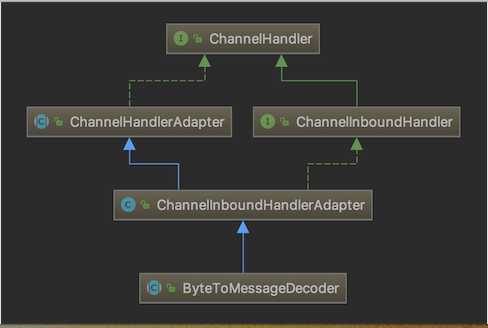标签:future string 详解 自动装箱 abs use mys turn ons
首先,我们回顾一下netty的组件设计:Netty的主要组件有Channel、EventLoop、ChannelFuture、ChannelHandler、ChannelPipe等。
ChannelHandler充当了处理入站和出站数据的应用程序逻辑的容器。例如,实现ChannelInboundHandler接口(或ChannelInboundHandlerAdapter),你就可以接收入站事件和数据,这些数据随后会被你的应用程序的业务逻辑处理。当你要给连接的客户端发送响应时,也可以从ChannelInboundHandler冲刷数据。你的业务逻辑通常写在一个或者多个ChannelInboundHandler中。ChannelOutboundHandler原理一样,只不过它是用来处理出站数据的。
ChannelPipeline提供了ChannelHandler链的容器。以客户端应用程序为例,如果事件的运动方向是从客户端到服务端的,那么我们称这些事件为出站的,即客户端发送给服务端的数据会通过pipeline中的一系列ChannelOutboundHandler,并被这些Handler处理,反之则称为入站的。

当你通过Netty发送或者接受一个消息的时候,就将会发生一次数据转换。入站消息会被解码:从字节转换为另一种格式(比如java对象);如果是出站消息,它会被编码成字节。
Netty提供了一系列实用的编码解码器,他们都实现了ChannelInboundHadnler或者ChannelOutcoundHandler接口。在这些类中,channelRead方法已经被重写了。以入站为例,对于每个从入站Channel读取的消息,这个方法会被调用。随后,它将调用由已知解码器所提供的decode()方法进行解码,并将已经解码的字节转发给ChannelPipeline中的下一个ChannelInboundHandler。

由于你不可能知道远程节点是否会一次性发送一个完整的信息,tcp有可能出现粘包拆包的问题,这个类会对入站数据进行缓冲,直到它准备好被处理。
主要api有两个:
public abstract class ByteToMessageDecoder extends ChannelInboundHandlerAdapter {
protected abstract void decode(ChannelHandlerContext ctx, ByteBuf in, List<Object> out) throws Exception;
protected void decodeLast(ChannelHandlerContext ctx, ByteBuf in, List<Object> out) throws Exception { if (in.isReadable()) { // Only call decode() if there is something left in the buffer to decode. // See https://github.com/netty/netty/issues/4386 decodeRemovalReentryProtection(ctx, in, out); } } }
decode方法:
必须实现的方法,ByteBuf包含了传入数据,List用来添加解码后的消息。对这个方法的调用将会重复进行,直到确定没有新的元素被添加到该List,或者该ByteBuf中没有更多可读取的字节时为止。然后如果该List不会空,那么它的内容将会被传递给ChannelPipeline中的下一个ChannelInboundHandler。
decodeLast方法:
当Channel的状态变成非活动时,这个方法将会被调用一次。
最简单的例子:

public class ToIntegerDecoder extends ByteToMessageDecoder { @Override protected void decode(ChannelHandlerContext ctx, ByteBuf in, List<Object> out) throws Exception { if (in.readableBytes() >= 4) { out.add(in.readInt()); } } }
这个例子,每次入站从ByteBuf中读取4字节,将其解码为一个int,然后将它添加到下一个List中。当没有更多元素可以被添加到该List中时,它的内容将会被发送给下一个ChannelInboundHandler。int在被添加到List中时,会被自动装箱为Integer。在调用readInt()方法前必须验证所输入的ByteBuf是否具有足够的数据。
一个实用的例子:
public class MyDecoder extends ByteToMessageDecoder { @Override protected void decode(ChannelHandlerContext ctx, ByteBuf in, List<Object> out) throws Exception { if (in.readableBytes() < 4) { return; }
//在读取前标记readerIndex in.markReaderIndex();
//读取头部 int length = in.readInt(); if (in.readableBytes() < length) {
//消息不完整,无法处理,将readerIndex复位 in.resetReaderIndex(); return; } out.add(in.readBytes(length).toString(CharsetUtil.UTF_8)); } }
public abstract class ReplayingDecoder<S> extends ByteToMessageDecoder
ReplayingDecoder扩展了ByteToMessageDecoder类,使用这个类,我们不必调用readableBytes()方法。参数S指定了用户状态管理的类型,其中Void代表不需要状态管理。
以上代码可以简化为:
public class MySimpleDecoder extends ReplayingDecoder<Void> { @Override protected void decode(ChannelHandlerContext ctx, ByteBuf in, List<Object> out) throws Exception { //传入的ByteBuf是ReplayingDecoderByteBuf //首先从入站ByteBuf中读取头部,得到消息体长度length,然后读取length个字节, //并添加到解码消息的List中 out.add(in.readBytes(in.readInt()).toString(CharsetUtil.UTF_8)); }
如何实现的?
ReplayingDecoder在调用decode方法时,传入的是一个自定义的ByteBuf实现:
final class ReplayingDecoderByteBuf extends ByteBuf
ReplayingDecoderByteBuf在读取数据前,会先检查是否有足够的字节可用,以readInt()为例:
final class ReplayingDecoderByteBuf extends ByteBuf { private static final Signal REPLAY = ReplayingDecoder.REPLAY; ...... @Override public int readInt() { checkReadableBytes(4); return buffer.readInt(); } private void checkReadableBytes(int readableBytes) { if (buffer.readableBytes() < readableBytes) { throw REPLAY; } } ...... }
如果字节数量不够,会抛出一个Error(实际是一个Signal public final class Signal extends Error implements Constant<Signal> ),然后会在上层被捕获并处理,它会把ByteBuf中的ReadIndex恢复到读之前的位置,以供下次读取。当有更多数据可供读取时,该decode()方法将会被再次调用。最终结果和之前一样,从ByteBuf中提取的String将会被添加到List中。
虽然ReplayingDecoder使用方便,但它也有一些局限性:
1. 并不是所有的 ByteBuf 操作都被支持,如果调用了一个不被支持的方法,将会抛出一个 UnsupportedOperationException。
2. ReplayingDecoder 在某些情况下可能稍慢于 ByteToMessageDecoder,例如网络缓慢并且消息格式复杂时,消息被拆成了多个碎片,于是decode()方法会被多次调用反复地解析一个消息。
3. 你需要时刻注意decode()方法在同一个消息上可能被多次调用.。
一个简单的echo服务,客户端在连接建立时,向服务端发送消息(两个1)。服务端需要一次拿到两个Integer,并做处理。
EchoServerHandler
public class EchoServerHandler extends ChannelInboundHandlerAdapter { @Override public void channelRead(ChannelHandlerContext ctx, Object msg) throws Exception { System.out.println("msg from client: " + msg); } @Override public void channelReadComplete(ChannelHandlerContext ctx) throws Exception { } @Override public void exceptionCaught(ChannelHandlerContext ctx, Throwable cause) throws Exception { cause.printStackTrace(); ctx.close(); } }
EchoClientHandler
public class EchoClientHandler extends ChannelInboundHandlerAdapter { @Override public void channelActive(ChannelHandlerContext ctx) throws Exception { System.out.println("sent to server: 11"); ctx.writeAndFlush(1); Thread.sleep(1000); ctx.writeAndFlush(1); } @Override public void channelRead(ChannelHandlerContext ctx, Object msg) throws Exception { } @Override public void channelReadComplete(ChannelHandlerContext ctx) throws Exception { } @Override public void exceptionCaught(ChannelHandlerContext ctx, Throwable cause) throws Exception { cause.printStackTrace(); ctx.close(); } }
解码器
public class MyReplayingDecoder extends ReplayingDecoder<Void> { private final Queue<Integer> values = new LinkedList<>(); @Override protected void decode(ChannelHandlerContext ctx, ByteBuf in, List<Object> out) throws Exception { values.add(in.readInt()); values.add(in.readInt()); assert values.size() == 2; out.add(values.poll() + values.poll()); } }
运行程序,就会发现断言失败。
我们通过在decode()方法中打印日志或者打断点的方式,可以看到,decode()方法是被调用了两次的,分别在服务端两次接受到消息的时候:
第一次调用时,由于缓冲区中只有四个字节,在第二句 values.add(in.readInt()) 中抛出了异常REPLAY,在ReplayingDecoder中被捕获,并复位ReadIndex。此时values.size() = 1。
第二次调用时,从头开始读取到两个Integer并放入values,因此values.size() = 3。
@Override protected void decode(ChannelHandlerContext ctx, ByteBuf in, List<Object> out) throws Exception { //清空队列 values.clear(); values.add(in.readInt()); values.add(in.readInt()); assert values.size() == 2; out.add(values.poll() + values.poll()); }
如何提高ReplayingDecoder的性能?如上所说,使用ReplayingDecoder存在对一个消息多次重复解码的问题,我们可以通过Netty提供的状态控制来解决这个问题。
首先我们将消息结构设计为:header(4个字节,存放消息体长度),body(消息体)
根据消息的结构,我们定义两个状态:
public enum MyDecoderState { /** * 未读头部 */ READ_LENGTH, /** * 未读内容 */ READ_CONTENT; }
EchoClientHandler
public class EchoClientHandler extends ChannelInboundHandlerAdapter { @Override public void channelActive(ChannelHandlerContext ctx) throws Exception { for (int i = 0; i < 10; i++) { System.out.println("sent to server: msg" + i); ctx.writeAndFlush("msg" + i); } } @Override public void channelRead(ChannelHandlerContext ctx, Object msg) throws Exception { } @Override public void channelReadComplete(ChannelHandlerContext ctx) throws Exception { } @Override public void exceptionCaught(ChannelHandlerContext ctx, Throwable cause) throws Exception { cause.printStackTrace(); ctx.close(); } }
EchoServerHandler
public class EchoServerHandler extends ChannelInboundHandlerAdapter { @Override public void channelRead(ChannelHandlerContext ctx, Object msg) throws Exception { System.out.println("msg from client: " + ((ByteBuf) msg).toString(CharsetUtil.UTF_8)); } @Override public void channelReadComplete(ChannelHandlerContext ctx) throws Exception { } @Override public void exceptionCaught(ChannelHandlerContext ctx, Throwable cause) throws Exception { cause.printStackTrace(); ctx.close(); } }
解码器
public class IntegerHeaderFrameDecoder extends ReplayingDecoder<MyDecoderState> { private int length; public IntegerHeaderFrameDecoder() { // Set the initial state. super(MyDecoderState.READ_LENGTH); } @Override protected void decode(ChannelHandlerContext ctx, ByteBuf in, List<Object> out) throws Exception { switch (state()) { case READ_LENGTH: length = in.readInt(); checkpoint(MyDecoderState.READ_CONTENT); case READ_CONTENT: ByteBuf frame = in.readBytes(length); checkpoint(MyDecoderState.READ_LENGTH); out.add(frame); break; default: throw new Error("Shouldn‘t reach here."); } } }
编码器
public class MyEncoder extends MessageToByteEncoder<String> { @Override protected void encode(ChannelHandlerContext ctx, String msg, ByteBuf out) throws Exception { byte[] b = msg.getBytes(); int length = b.length; //write length of msg out.writeInt(length); //write msg out.writeBytes(b); } }
当头部被成功读取到时,我们调用 checkpoint(MyDecoderState.READ_CONTENT) 设置状态为“未读消息”,相当于设置一个标志位,如果在后续读取时抛出异常,那么readIndex会被复位到上一次你调用checkpoint()方法的地方。下一次接收到消息,再次调用decode()方法时,就能够从checkpoint处开始读取,避免了又从头开始读。
LineBasedFrameDecoder
这个类在Netty内部也有使用,它使用行尾控制字符(\n或者\r\n)作为分隔符来解析数据。
DelimiterBasedFrameDecoder
使用自定义的特殊字符作为消息的分隔符。
HttpObjectDecoder
一个HTTP数据的解码器。
这些解码器也非常实用,下次更新关于这些解码器的原理和详细使用。
更多详细内容参见《netty in action》 或者netty源码的英文注释。
标签:future string 详解 自动装箱 abs use mys turn ons
原文地址:https://www.cnblogs.com/yuanrw/p/9866356.html